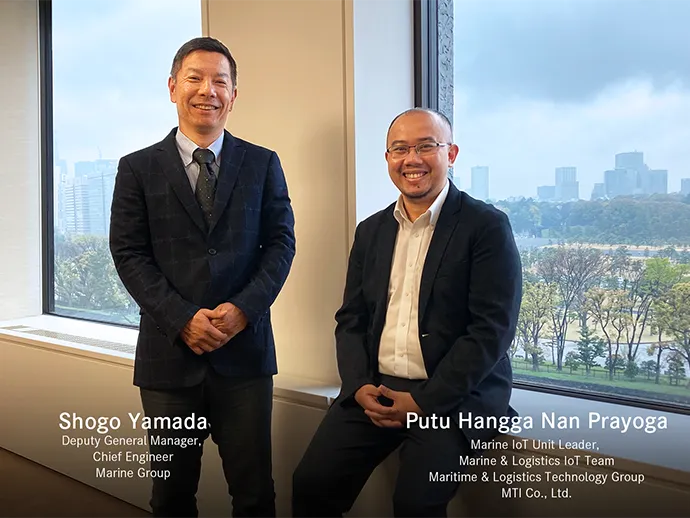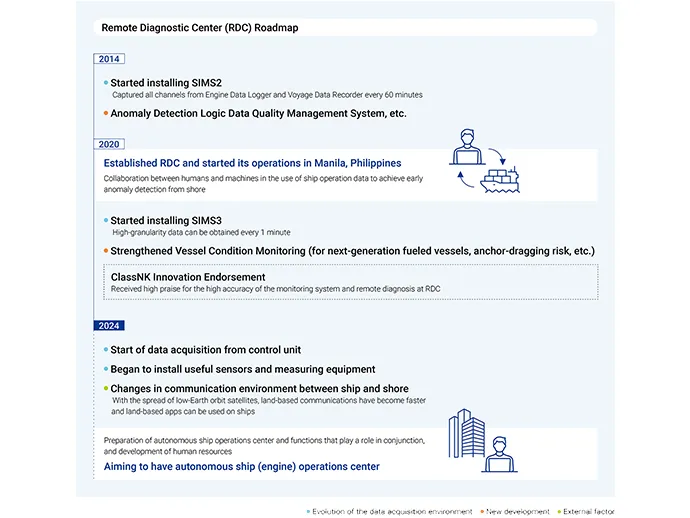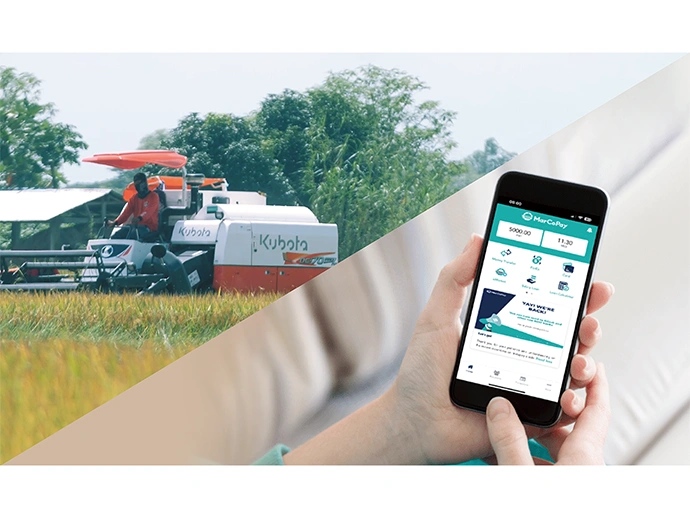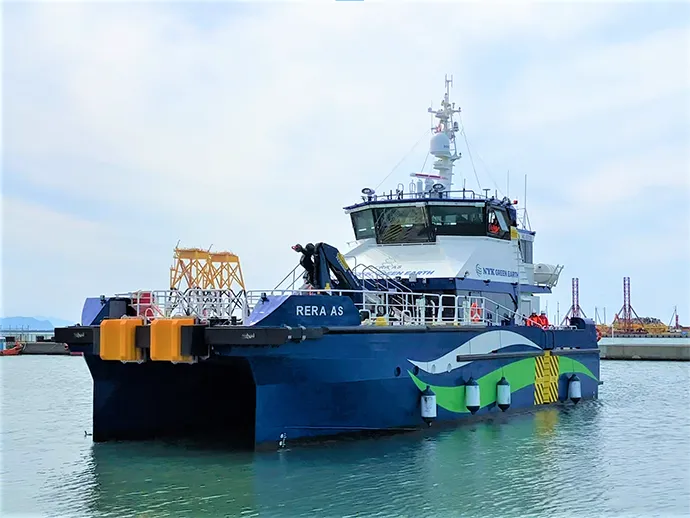Enhancing Operational Technology by Combining the Strengths of Humans and Machines through the Utilization of Ship Data
Released : Jan. 22, 2025
Updated : Jan. 16, 2025

Making Strides in the Utilization of Data
In response to the current high level of fuel oil prices, we have been looking for ways to improve the efficiency of ship operations. Between 2002 and the summer of 2008, the global price of crude oil soared. It rose at an annual rate of 25% to reach an all-time high in July 2008. As the operators of ships fueled by heavy oil, shipping companies were under pressure to adapt to this challenging business environment. With the aim of realizing fuel-saving ship operations through data visualization, NYK and Group company MTI Co., Ltd., worked together to develop the Ship Information Management System (SIMS), which collects data on ship position, speed, and fuel consumption. In 2008, we began using satellite communication to share the data collected by SIMS with onshore operations, which enabled crew members and onshore personnel to jointly pursue fuel-saving ship operations. Over approximately six years, the system was installed on more than 50 ships, including container ships. As a result, we reduced fuel costs by approximately 10% and lowered operational costs by hundreds of billions of yen. In 2014, we began installing SIMS2, a support system that can also collect engine-related data. We have to date equipped approximately 200 ships with this system. In addition to enabling the efficient collection of ship data, SIMS2 has facilitated the sharing of such data between onshore and offshore operations. Moreover, we have developed applications that support the early detection of engine problems, preventive maintenance, and safe ship operations.
Deputy General Manager Shogo Yamada, who leads the Big Data Utilization Team of NYK’s Marine Group, emphasizes the uniqueness of the Company.
“We visited and held discussions with shipping companies and ship-management companies around the world, all of which are working on the monitoring of voyage-related data. However, we did not come across any other shipping companies that collect and analyze engine-related data in the way that we do. In this sense, NYK is engaged in a very progressive and unique initiative.”

Large ships are equipped with devices that record and collect voyage-related data on their position, direction, and speed during voyages, as well as devices that collect data on the temperature, pressure, and flow rate of engines. The version of SIMS3 currently on board ships collects at least 1,000 data points per ship and in some cases collects more than 2,000 data points per ship, transmitting them to shore every minute via a communications satellite. Yamada, who has extensive experience as a chief engineer, emphasizes the importance of frontline experience.
“In utilizing data, technologies that collect and process the data are of course important. However, what is even more important is having an intuitive understanding of frontline operations that allows you to determine what the data is indicating. For example, sometimes changes in exhaust gas temperatures, even when within a normal range mechanically speaking, can in fact be the precursors of engine failures. Identifying such warnings still requires frontline experience and a wealth of knowledge.”
The NYK Group is one step ahead of others in data collection and utilization precisely because it has a wealth of knowledge and data accumulated over a long history in the maritime shipping industry, as well as crew members who have frontline capabilities. In fact, in 2018 the Group drew on the insight it had hitherto acquired through the utilization of data to help establish two international standards: ISO 19847 (shipboard data servers to share field data at sea) and ISO 19848 (standard data for shipboard machinery and equipment). Through international standardization activities, we are contributing to the creation of rules and the establishment of an environment for data utilization in the maritime shipping industry.
The NYK Group is continuing its progress in data utilization by upgrading technologies. In 2020, these efforts led to the creation of a third-generation system, SIMS3, which we have been installing on board our operating ships since 2021. Of the more than 200 ships equipped with SIMS, 96 had been equipped with SIMS3 as of the end of May 2024. The system is facilitating the rapid, high-frequency sharing of detailed onboard data between ships and onshore operations. This has enhanced our ability to detect problems with onboard equipment early and to detect initial anomalies in real time. The system also makes it possible to understand situations in detail and increases the accuracy of responses. SIMS3 is expected to reduce fuel costs by roughly ¥30 billion annually. Moreover, the detailed data collected and the insight gained from its utilization are contributing to the design and manufacture of safer, more-efficient ships and equipment.
Broadening the Scope of Utilization from Fuel Saving to Safe Ship Operations
The speed of communication between ships and land is said to lag behind that of onshore communication by 10 years. Until just a few years ago, accessing the internet on board a ship was difficult, let alone watching streaming videos. Thanks to the spread of satellite-based communication services, accessing the internet at speeds of up to 220 Mbps (megabits per second) has now become possible, making internet communication on board almost as fast and of the same quality as that on land. With the increase in communication speeds, the NYK Group’s data utilization initiatives have evolved. The upgrade from SIMS to SIMS2 increased the variety of data that could be handled and shortened data transmission intervals, enabling the acquisition of precise data in a timelier manner. We used the large volumes of data to visualize precursors of problems in ship operations. As a result, the utilization of data, which began as a fuel-saving activity, increased in scope to become an initiative that supports safe ship operations. Yamada explains the advantages of SIMS2.
“Before the introduction of SIMS2, only crew members on board ships could detect and respond to anomalies during ship operations. Now, based on the same data, we can support responses from onshore. That is the greatest merit of SIMS2. Many different people are now able to see the situation of ships, which I think has definitely raised the level of NYK’s safety management.”
On the other hand, even though data is acquired at one-minute intervals, round-the-clock human monitoring of the more than 200 ships equipped with SIMS2 is unrealistic. Therefore, we began developing an AI-enabled machine learning model that detects anomalies during ship operations based on data from an array of sensors. The difficulties involved in creating the logic for anomaly detection are described by Putu Hangga Nan Prayoga, the Marine IoT Unit Leader of the Maritime & Logistics Technology Group at MTI, which is an R&D subsidiary of NYK.
“To give an example, detecting anomalous exhaust gas temperatures is simple. For the NYK Group, however, the logic is complex because data from all kinds of sensors—from voyage-related data through to engine-related data—is combined to determine anomalies. The system’s conclusions are not always 100% correct. When the system went into operation, its accuracy was about 50%. Since then, a series of rigorous improvements has raised the system’s accuracy to 98%. If all you want to do is detect changes in data, this can be done with trained AI. The problem is understanding whether the change is anomalous or not and what the anomaly means. We spent months relentlessly creating a logic that took these problems into account. In the process, we developed around 2,000 prototype logics and methods, which were thoroughly tested and able to implement the best-performing solution into production.”
Even with a system that has been developed to this degree, the results of anomaly detection by AI are not perfect. For this reason, we created a system in which chief engineers and other experts with onboard experience and expertise scrutinize the results. At the core of this system is the Remote Diagnostic Center (RDC), which was established in the Philippines in 2020. AI monitors the behavior of fluctuations in the data obtained from various sensors and generates scores for the anomalies. If a score exceeds a predetermined level, the RDC is notified, and experts conduct analysis. Cases of false detection by AI are filtered out to leave only cases where an anomaly is genuinely suspected. The ship in question and its ship-management company are notified. The results of their countermeasures are then fed back to the RDC. Through this cycle, the system is continuously improving by learning from feedback provided by experts and frontline personnel. Consequently, our anomaly detection is becoming ever more precise. Hangga gives an overview of the ongoing drive to evolve the system further still.
“In addition to the data obtained from SIMS, experts’ comments are very valuable for machine learning. A manager from an engine manufacturer was surprised at the wealth of data we have. Currently, we collect at least 1,000 data points, and for some ships we collect more than 2,000 data points. In the future, this is expected to rise to 10,000. As collectible data points increase, we will be able to understand situations in greater detail. As well as enhancing anomaly detection, this may enable anomaly prediction.”
Evolving Further with an Eye to Autonomous Ship Operations
Anomaly detection systems will also be an indispensable technology for the autonomous ships that we plan to introduce. For the safe, stable operation of autonomous ships with fewer crew members, the detection of anomalies by onshore operations will become more critical than ever. The RDC has thus set out a road map that envisions the RDC functioning as an operations center for autonomous ships. We are presently advancing various measures to make this vision a reality.

One ship per week is being converted from SIMS2 to SIMS3. In addition to conventional data, we are conducting a series of tests to incorporate data on engines that use next-generation fuels as well as data on cargoes themselves. The NYK Group is seeing the completion of next-generation fuel ships in rapid succession, including LNG-fueled ships and ammonia-fueled ships. As they differ from conventional heavy oil-fueled ships and have complex engine mechanisms, next-generation fuel ships require the installation of additional sensors. Onshore, we have revamped applications so that they can display data specific to next-generation fuel ships. For example, LNG carriers use as fuel LNG that evaporates during transportation. We are now able to acquire data on how much LNG is evaporating. Yamada explains data quality.
“There are two forms of data quality: data accuracy and data value. The former refers to the arrival of data on time, free from errors, and reflects the truth as closely as possible. The latter means the worth or preciousness of data in contributing to organizational goals and outcomes. We have refined data accuracy to quite an extent. Now, we want to further heighten data value. We are proceeding with a plan to install new sensors on ships by the end of fiscal 2024.”
Hangga enjoys the challenge of developing the system.
“I cannot think of any other workplace where so much real-time data is collected on a daily basis. At the moment, I am working on more than 15 projects, which is very rewarding for me as a researcher. In addition, R&D expenses are not met by subsidies but from the company’s profits. Given that operations are only possible thanks to the efforts of frontline personnel, one of my motivations is to build a system that is useful to them.”
Yamada has an elevated perspective and a broad vision.
“In 2008, few people agreed with idea of data acquisition and utilization. Nevertheless, we repeatedly explained the future benefits and increased the adopters of the system. As a result, data is now being collected and utilized as a matter of course. Data will be the source of corporate value going forward. I am convinced that making the most of data will benefit the Company. Human resource development cannot wait. I also hope that young digital natives will see us as an attractive company. The mechanisms for creating added value are changing. Development of the necessary data, analysis technology, and infrastructure as well as collaboration with equipment manufacturers, universities, and other interested parties will become increasingly crucial for pursuing overall optimization.”
The NYK Group is an industry pioneer in the utilization of ship data. We will also promote the commercialization of the expertise we acquire and external sales of the systems we develop. As it further improves operational technology, the NYK Group is advancing toward a promising future.
Interview April 3, 2024






